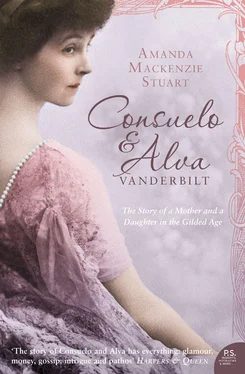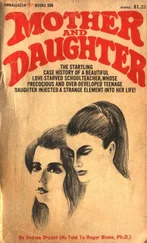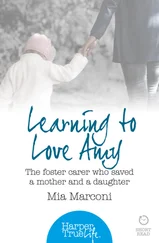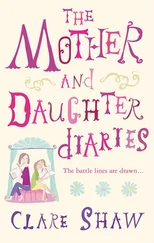Before his relationship with Alva, Oliver Belmont was often to be found in the Oelrichs household, charming Blanche Oelrichs as a child. She liked his ‘slow urbanity, his face rutted with lines – from the hopes and disillusions of his life as a lover, I suspected. For certainly he must be a romantic man.’ 19 The circumstances surrounding the collapse of Oliver Belmont’s first marriage suggest that his behaviour was not always romantic. After a long courtship which was bitterly opposed by both his parents, Belmont married a beautiful socialite, Sara Whiting. On their honeymoon in Paris they were joined by Sara’s domineering mother and two sisters, who moved in with the newlyweds and refused to leave. Oliver eventually marched out on the ménage – understandable perhaps had he not stormed off in the company of an exotic Spanish dancer, bad form at any time, but especially on one’s honeymoon. On hearing that his new bride was pregnant he returned to Paris to attempt a reconciliation, only to find himself accused of heavy drinking and physical violence – allegations which he rebutted furiously. Sara Whiting later gave birth to a daughter, Natica, whom Belmont refused ever to acknowledge, while Mrs Whiting insisted on a divorce.
Oliver Belmont’s parents were mortified by the publicity surrounding his first marriage. They had in any case long despaired of him: in spite of various attempts to find him gainful employment he appeared to have no greater ambition than to live as a gentleman of leisure. As early as 1888 they were concerned that he was joining a cruise on the Alva , fearing that Vanderbilt sojourns in resorts such as Monte Carlo would do nothing to raise his level of ambition and knowing that his friendship with Mrs William K. Vanderbilt was already a talking point. 20 Oliver joined part or all of subsequent Vanderbilt cruises in 1889 and 1890, however. 21 Indeed, his obstinacy and readiness to ignore society’s opinion on this matter may have attracted Alva. Here was someone with strength of personality, someone to brace against, unlike William K. whom Alva later described as a ‘weak nonentity’. It may also be true, as Louis Auchincloss has written, that Oliver was attractive because he represented a challenge. He had already caused offence. There was just a whiff of violence about him. He was a Belmont. ‘One begins to suspect that the setting up of hurdles in order to jump them was her way of adding a bit of zest to the sameness of a social game that was already showing itself a drag to her lively spirit. And were not the Belmonts partly Jewish? Better and better!’ 22
Initially the relationship between Alva and Oliver Belmont raised few eyebrows for it was not unusual for the neglected wives of rich men to acquire ‘walkers’. ‘The Newport ladies of those days were trying hard to emulate their sisters in cosmopolitan Europe,’ writes Blanche Oelrichs; ‘and it would have been thought extremely “bourgeois” for attractive matrons not to have gentlemen about them who were “attentive”.’ 23 As the warmth of feeling between Alva and Belmont began to show, however, the gossips got down to work. ‘I used to think Oliver Belmont one of the handsomest men at the Coaching Parade, with his dark eyes, clear-cut profile and slender, faun-like grace,’ wrote Elizabeth Lehr, thinking back to her teens. ‘Mrs W. K. Vanderbilt often sat at his side on the box behind the four famous bays, Sandringham, Rockingham, Buckingham and Hurlingham. The women glanced at her as she sat wide-eyed and innocent-looking, and whispered to one another.’ 24 Town Topics also picked up Oliver’s constant presence at Alva’s side and talk persisted into later generations. In a delightful lecture about her childhood on Bellevue Avenue, Eileen Slocum remarked: ‘Down the years I especially remember the gossip about Mrs William K. Vanderbilt’s affair with Mr O. H. P. Belmont … Daddy was very critical … “Poor Willy K. drove up, unexpectedly, one day from the train in his carriage,” Daddy said, “and entered his own house and ascended his own staircase and found Mr Belmont hiding in the closet of his own bedroom. Willy should have shot him.”’ 25
It does seem perverse, therefore, that in the autumn of 1893, when their marriage was strained to the point of collapse, the Vanderbilts not only decided to go on a long cruise on the Valiant to India but invited Oliver Belmont to join them. It is just possible that Alva and Oliver were not yet lovers, for this would have put Alva, who was always political, at a disadvantage. Perhaps William K. welcomed Belmont’s presence because he improved Alva’s mood. Perhaps the expedition was William K.’s idea and Alva only agreed to go on condition she could take Oliver too. Consuelo later said that it was clear even to her that the cruise was a desperate last attempt to patch things up, one last effort to avoid ‘the rupture which I felt could not be long delayed’. The expedition set off in an atmosphere of ‘dread and uncertainty’ with a party that included ‘my parents, my brother Harold, a doctor, a governess and the three men friends who were our constant companions. Willie, being at school, remained at home. My mother, claiming that my governess gave sufficient trouble, refused to have another woman on board.’ 26 The three men friends whose names appear in the ship’s log were Oliver Belmont, Fred Beech and J. Louis Webb.
The cruise began on 23 November 1893 at 3.35 p.m. precisely with a total of eighty-five people on board, seen off by a crowd that ‘surged and pushed and jostled on the pier like animated stalks in a bunch of asparagus’. 27 The Valiant arrived in Bombay just over a month later, on Christmas Day. On 30 December, the Vanderbilt party disembarked for a two-week overland journey by special train to Calcutta, while the yacht made its way round from Bombay to await them. Alva was pleased to discover that the Taj Mahal had been inspired by the spirit of a woman. Otherwise, much of what she saw in India appalled her. If Alva was taken aback by what she described as superstition and ‘repulsive religious ceremonies’, 28 Consuelo was frankly terrified by such unusually close proximity to humanity en masse, particularly when it rattled at the doors of the Vanderbilt sleeping cars and tried to force an entry. ‘It was difficult to secure bath water and the food was incredibly nasty. We lived on tea, toast and marmalade … It was wonderful to find all the luxuries of home on the Valiant which had come round India from Bombay and lay anchored in the Hooghly.’ 29
What Consuelo did not know as she recuperated from this taxing journey, was that the stay in Calcutta would mark a turning-point in her life. While Consuelo, Harold, and the Vanderbilts’ friends remained on board the Valiant , Alva and William K. were invited to stay by the Viceroy of India, Lord Lansdowne, at Government House in Calcutta. Sometimes described as ‘the most neglected statesman in modern British history’ Lord Lansdowne (or Henry Charles Keith Petty-Fitzmaurice, 5th Marquess of Lansdowne), had already had a distinguished career as Governor-General of Canada and would go on to become Secretary of State for War, Foreign Secretary, leader of the Conservative and Unionist peers, and a member of Asquith’s wartime cabinet. At the time of the Vanderbilts’ visit to Calcutta, however, his sojourn in India as Viceroy was almost at an end, and, worn out by his tour of duty, he was longing to go home. Nonetheless, Lord and Lady Lansdowne extended generous hospitality to the Vanderbilts with the result that just when Alva was feeling most vulnerable to a life of ‘sunlight by proxy’ she witnessed the life of the Vicereine, Lady Lansdowne, when the British Raj was at its zenith.
‘We might as well be monarchs,’ 30 wrote Mary Curzon when she arrived as Vicereine herself three years later. Even aristocrats such as Lord Lansdowne, accustomed to palatial space and waited on since birth, found Government House in Calcutta somewhat grandiose. ‘Words cannot describe the hugeness of this place or the utter absence of anything like homely comfort … [The bedroom with its] colossal bed large enough for half a dozen couples … the ceiling which is so far up that one can scarcely see it,’ 31 he wrote to his mother. Historian David Cannadine suggests that the grandeur was a deliberate political ploy: ‘The British now saw themselves as the legitimate successors of the Mughal emperors, and came to believe that their regime should project a suitably “oriental” and “imperial” image. So they set out to construct a new ritual idiom for the government of India, partly based on the appropriation of what they believed were traditional Mughal court ceremonials, and partly invented and developed by themselves, through which they could express their own authority … The ceremonial surrounding the Viceroy, both in Calcutta and at Simla, and as he travelled round India, became increasingly splendid, ornate, elaborate and magnificent – far grander than the state in which British monarchs themselves lived at home.’ 32
Читать дальше












